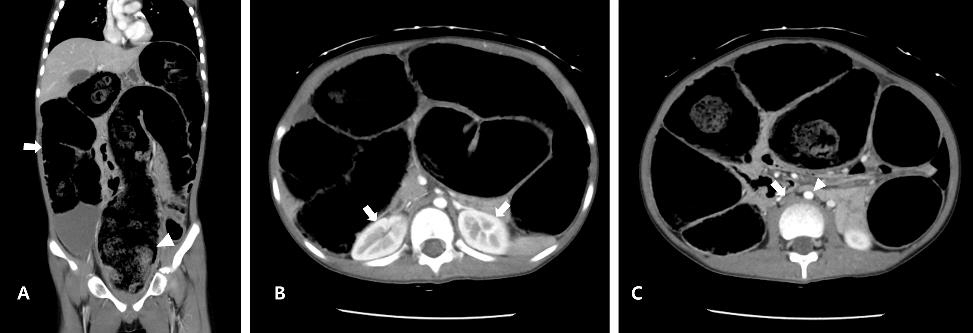Pediatr Emerg Med J.
2021 Dec;8(2):112-115. 10.22470/pemj.2021.00332.
Abdominal compartment syndrome in a 10-year-old boy with delayed presentation of congenital aganglionic megacolon
- Affiliations
-
- 1Department of Pediatrics, College of Medicine, The Catholic University of Korea, Uijeongbu, Korea
- KMID: 2524005
- DOI: http://doi.org/10.22470/pemj.2021.00332
Abstract
- Abdominal compartment syndrome (ACS) involves adverse physiologic consequences arising from the increased intra-abdominal pressure, leading to high mortality. However, this syndrome has been scarcely reported in pediatric emergency settings. We describe a 10-year-old boy with ACS presenting with painful abdominal distension, oliguria, and dyspnea. Despite the absence of known congenital anomalies, he had undergone frequent episodes of constipation since 5 years of age, and had not defecated for recent 2 months. With computed tomography scans showing the entire colorectal distension, his manifestations were considered to have stemmed from congenital aganglionic megacolon, which had gone undetected. This case underlines the needs for considering ACS and consequent surgical decompression in a child with severe abdominal distension.
Keyword
Figure
Reference
-
References
1. Thabet FC, Ejike JC. Intra-abdominal hypertension and abdominal compartment syndrome in pediatrics. A review. J Crit Care. 2017; 41:275–82.
Article2. Birkhahn BH, Gaeta TJ. Abdominal compartment syndrome in a patient with congenital megacolon. Pediatr Emerg Care. 2000; 16:176–8.
Article3. DeCou JM, Abrams RS, Miller RS, Gauderer MW. Abdominal compartment syndrome in children: Experience with three cases. J Pediatr Surg. 2000; 35:840–2.
Article4. Hecker A, Hecker B, Hecker M, Riedel JG, Weigand MA, Padberg W. Acute abdominal compartment syndrome: current diagnostic and therapeutic options. Langenbecks Arch Surg. 2016; 401:15–24.
Article5. Balogh ZJ, Malbrain M. Resuscitation in intra-abdominal hypertension and abdominal compartment syndrome. Am Surg. 2011; 77 Suppl 1:S31–3.6. Cheatham ML. Abdominal compartment syndrome: pathophysiology and definitions. Scand J Trauma Resusc Emerg Med. 2009; 17:10.
Article7. Kirkpatrick AW, Roberts DJ, De Waele J, Jaeschke R, Malbrain ML, De Keulenaer B. Intra-abdominal hypertension and the abdominal compartment syndrome: updated consensus definitions and clinical practice guidelines from the World Society of the Abdominal Compartment Syndrome. Intensive Care Med. 2013; 39:1190–206.
Article8. Stassen NA, Lukan JK, Dixon MS, Carrillo EH. Abdominal compartment syndrome. Scand J Surg. 2002; 91:104–8.
Article9. Kron IL, Harman PK, Nolan SP. The measurement of intra-abdominal pressure as a criterion for abdominal re-exploration. Ann Surg. 1984; 199:28–30.
Article10. Kyoung KH, Hong SK. The duration of intra-abdominal hypertension strongly predicts outcomes for the critically ill surgical patients: a prospective observational study. World J Emerg Surg. 2015; 10:22.
Article11. Je BK, Kim HK, Horn PS. Abdominal compartment syndrome in children: clinical and imaging features. AJR Am J Roentgenol. 2019; 212:655–64.
Article
- Full Text Links
- Actions
-
Cited
- CITED
-
- Close
- Share
- Similar articles
-
- Severe hyponatremia and repeated intestinal resections for intestinal dysmotility mimicking congenital aganglionic megacolon due to delay in the diagnosis of congenital hypothyroidism
- Cardiac Arrest in a Patient with a Severely Distended Colon
- Clinical Observation of Congenital Aganglionic Megacolon in Infancy and Childhood
- Small-bowel bezoars in an infant following synbiotic ingestion: a novel case report
- Thenar Compartment syndrome: A Case Report



